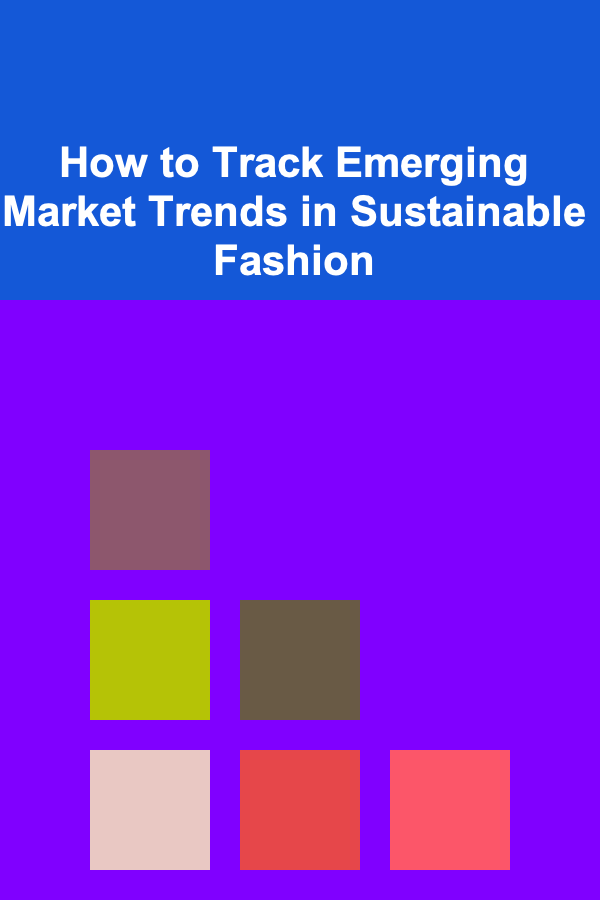
How to Track Emerging Market Trends in Sustainable Fashion
ebook include PDF & Audio bundle (Micro Guide)
$12.99$5.99
Limited Time Offer! Order within the next:

The world of fashion has been undergoing a significant transformation in recent years, with sustainability emerging as a central focus. As consumers become more environmentally conscious, and as the fashion industry faces increasing pressure to reduce its environmental impact, the demand for sustainable fashion is rising. This shift is creating new market opportunities, but also presents challenges in keeping up with emerging trends. Tracking these trends is crucial for businesses, designers, and consumers alike to stay ahead of the curve and contribute to a more sustainable fashion future.
In this article, we will explore how to effectively track emerging market trends in sustainable fashion, examining key tools, strategies, and resources to help you understand and respond to the ever-evolving landscape of sustainable fashion.
Understanding Sustainable Fashion: A Brief Overview
Before diving into how to track emerging trends, it's important to understand what sustainable fashion entails. Sustainable fashion refers to clothing, accessories, and footwear produced with a focus on minimizing environmental impact and promoting ethical production practices. This includes:
- Sustainable Materials: Using eco-friendly fabrics like organic cotton, hemp, and recycled fibers.
- Ethical Manufacturing: Ensuring fair labor practices, safe working conditions, and fair wages for workers.
- Waste Reduction: Focusing on circular fashion, where garments are designed to be reused, repaired, or recycled at the end of their life.
- Carbon Footprint Reduction: Using low-impact dyes, reducing water consumption, and minimizing transportation emissions.
As these principles become more mainstream, sustainable fashion has transcended its niche status and is becoming an integral part of the fashion industry.
Key Drivers of Sustainable Fashion Trends
Several factors are driving the growth of sustainable fashion. Understanding these drivers can provide valuable insights into where the market is heading and how you can track its trends effectively.
Consumer Demand
Consumers, particularly younger generations, are increasingly demanding sustainable and ethical products. According to reports from organizations like McKinsey & Company, Gen Z and Millennials are willing to pay more for fashion items that align with their values, especially those that are environmentally friendly. Tracking consumer behavior through social media, surveys, and focus groups can provide valuable insights into the kinds of sustainable fashion products that are gaining traction.
Regulatory Pressures
Governments around the world are implementing stricter regulations to curb the fashion industry's environmental footprint. For example, the European Union's Green Deal and new legislation in countries like France and the UK are mandating that fashion brands disclose their sustainability practices and reduce waste. Keeping an eye on policy changes and regulations in key markets can help you stay informed about emerging trends in sustainable fashion.
Innovation in Materials and Technology
Advancements in materials science are playing a significant role in shaping the future of sustainable fashion. Innovations like bio-fabricated materials, plant-based leathers, and new recycling technologies are enabling brands to reduce their reliance on conventional, resource-heavy materials. Keeping track of innovations in textile technology, such as the use of algae-based fabrics or the development of closed-loop recycling systems, will be critical to understanding the direction of sustainable fashion.
Corporate Sustainability Commitments
Many major fashion brands are making bold sustainability commitments as part of their corporate social responsibility (CSR) strategies. Brands like Patagonia, Stella McCartney, and Nike are leading the way with initiatives that focus on using sustainable materials, reducing waste, and ensuring fair labor practices. Monitoring the sustainability efforts of these and other leading brands can provide valuable insights into the broader industry's trajectory.
Tools and Strategies to Track Emerging Trends
Tracking emerging trends in sustainable fashion requires a multi-faceted approach. Here are some effective tools and strategies to keep you informed.
1. Industry Reports and Market Research
Industry reports from organizations such as McKinsey & Company, the Global Fashion Agenda, and Fashion Revolution provide in-depth analysis of sustainable fashion trends. These reports often include data on consumer preferences, industry growth, and forecasts for future trends. By subscribing to these reports or accessing them through academic institutions, you can gain a comprehensive understanding of the sustainable fashion market.
2. Social Media and Influencer Insights
Social media platforms like Instagram, TikTok, and Pinterest are powerful tools for identifying emerging trends in real-time. Fashion influencers, particularly those advocating for sustainable fashion, can provide early indicators of shifts in consumer preferences. Following sustainable fashion hashtags like #SustainableFashion, #EcoFriendlyFashion, and #SlowFashion can give you a pulse on the latest trends and discussions within the community.
3. Fashion Weeks and Trade Shows
Fashion weeks and trade shows, especially those focused on sustainability, are excellent venues for observing new trends and innovations in sustainable fashion. Events like the Copenhagen Fashion Summit and Eco Fashion Week provide a platform for designers and brands to showcase their latest sustainable collections and ideas. Attending these events, either virtually or in person, can offer a firsthand look at the direction the industry is headed.
4. Sustainability Certifications and Standards
Many fashion brands are seeking certifications from organizations like GOTS (Global Organic Textile Standard), Fair Trade, and B Corp to prove their sustainability claims. Monitoring the growth of certified sustainable brands can help you track which companies are leading the way in terms of sustainable practices. Additionally, keeping an eye on emerging sustainability standards and certifications can give you insight into which practices are becoming industry norms.
5. Trend Forecasting Services
Trend forecasting services like WGSN and Fashion Snoops provide detailed predictions of upcoming trends in fashion, including sustainability-related shifts. These services use data analytics, social media monitoring, and consumer behavior research to predict future trends. By subscribing to these services, you can gain valuable foresight into how sustainability will evolve in the fashion industry.
6. Collaborations and Partnerships
Watch for collaborations between fashion brands and environmental organizations or tech companies. These partnerships often lead to innovative solutions that push the boundaries of sustainability in fashion. For example, the collaboration between Adidas and Parley for the Oceans to create shoes made from recycled ocean plastic is an example of how brand partnerships are influencing the market. Monitoring these partnerships will give you a sense of the direction in which sustainable fashion is moving.
Emerging Trends in Sustainable Fashion
While the sustainable fashion market is still in its early stages, several key trends are beginning to emerge.
1. Circular Fashion
Circular fashion is gaining traction as a way to reduce waste and keep materials in use for longer. Brands are increasingly designing garments with their entire lifecycle in mind, using materials that can be recycled or repurposed. Consumers are also becoming more interested in second-hand fashion, clothing swaps, and rental services as part of this trend. Platforms like ThredUp and Depop are gaining popularity as the demand for circular fashion increases.
2. Eco-Friendly Fabrics
The use of eco-friendly fabrics is one of the most visible trends in sustainable fashion. Materials like organic cotton, Tencel, and hemp are becoming more common as alternatives to conventional textiles. Additionally, there is growing interest in plant-based fabrics, such as those made from mushrooms or pineapple fibers, as well as recycled materials like polyester made from plastic bottles.
3. Slow Fashion Movement
The slow fashion movement advocates for buying fewer, higher-quality items that are designed to last longer. This trend opposes the fast fashion model, which promotes cheap, disposable clothing. As consumers become more mindful of their purchasing habits, the demand for slow fashion brands that prioritize quality, craftsmanship, and ethical production is on the rise.
4. Technology and Fashion Innovation
Technology is playing an increasingly important role in driving sustainability in fashion. Innovations like 3D printing, AI-powered design tools, and blockchain for tracking supply chains are changing the way fashion is created and consumed. These technologies help reduce waste, improve efficiency, and provide transparency in production processes.
5. Transparency and Ethical Sourcing
Consumers are demanding more transparency from fashion brands regarding how their products are made. This includes information on sourcing, labor practices, and environmental impact. Brands that provide detailed information about their supply chain and manufacturing processes are gaining consumer trust and loyalty.
Conclusion
Tracking emerging trends in sustainable fashion is essential for staying informed about the direction of the industry. By leveraging tools such as market research reports, social media, and trend forecasting services, you can keep a pulse on the latest developments. Understanding key drivers of sustainable fashion, such as consumer demand, innovation, and regulatory changes, will help you make informed decisions whether you're a consumer, designer, or industry professional. As the sustainable fashion movement continues to grow, staying ahead of the curve will enable you to contribute to a more sustainable future for the fashion industry.
Reading More From Our Other Websites
- [Home Budget 101] How to Budget for Home Energy Costs: Save on Utilities This Winter
- [Home Family Activity 101] How to Plan a Family-Friendly DIY Spa Day
- [Organization Tip 101] How to Use Display Cases for Fragile Vintage Items
- [Organization Tip 101] How to Use Time Blocking to Optimize Your Workday
- [Organization Tip 101] How to Develop a Routine for Maintaining Bathroom Organization
- [Survival Kit 101] Essential Emergency Preparedness Kits: A Complete Guide to Survival
- [Home Soundproofing 101] How to Use Curtains to Soundproof Your Home Effectively
- [Gardening 101] The Benefits of Using Garden Compost for Sustainable Gardening
- [Home Cleaning 101] How to Tidy Up and Clean Your Home Before a Big Event
- [Organization Tip 101] How to Store and Organize Your Hose and Watering Equipment

Smart and Stylish: Thrifty Clothing Shopping Strategies for Every Budget
Read More
Smart Ways to Use Student Discounts for Budget-Friendly Shopping
Read More
How To Pair Wine with Breakfast Dishes
Read More
How to Learn Basic Knitting or Crocheting
Read More
How to Diagnose and Treat Common Fish Diseases: A Checklist
Read More
How to Integrate IoT with Existing Enterprise Systems
Read MoreOther Products

Smart and Stylish: Thrifty Clothing Shopping Strategies for Every Budget
Read More
Smart Ways to Use Student Discounts for Budget-Friendly Shopping
Read More
How To Pair Wine with Breakfast Dishes
Read More
How to Learn Basic Knitting or Crocheting
Read More
How to Diagnose and Treat Common Fish Diseases: A Checklist
Read More